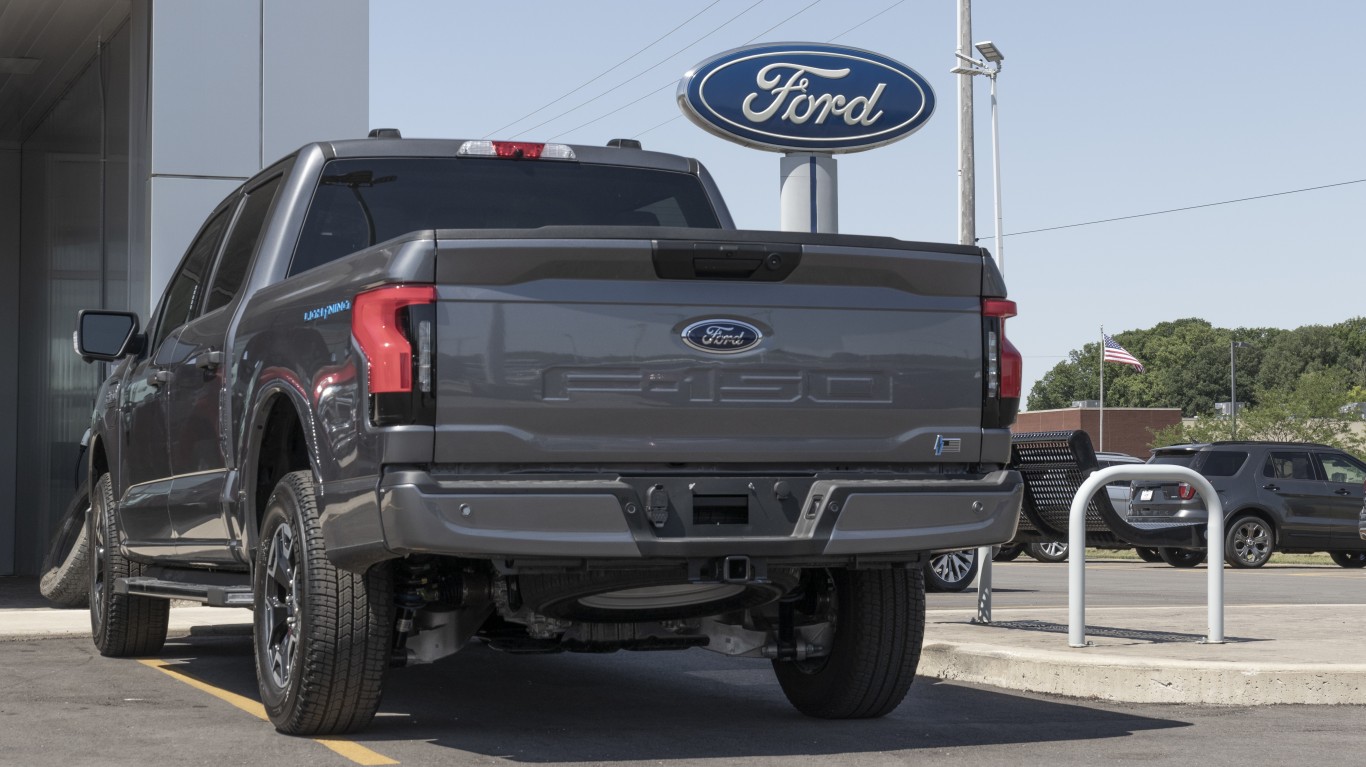Investing
Ford (F) Stock Price Prediction in 2030: Bull, Base and Bear Forecasts

Published:
Last Updated:

Ford Motor Company is an automotive industry icon, but it’s a period of profound change as the industry shifts toward electric vehicles (EV), sustainability, and tech integration. We examine Ford’s financials, market trends, and strategic steps to forecast its stock price in 2030 under 3 scenarios: Bull, Base, and Bear. 24/7Wall St. presents investors with an in-depth look at the rounds that Ford may make between now and the end of the decade.
As of February 2024, Ford has impressive financial metrics, but with challenges. The company has a market cap of $47.6 billion and trades a trailing 12-month (TTM) P/E of 7.91, which represents a discount price relative to its industry sector. Revenue TTM is $174.2 billion, and net income is $6.2 billion, with earnings per share (TTM) of $1.53, which is impressive profitability, especially in the current auto market of wide fluctuations.
What Factors Could Drive Ford’s Stock Up Or Down?
Ford’s stock has potential to see meaningful upside from its EV strategy delivering results, global sales expansion, and sustained operational efficiency. Key drivers would likely include continued strength in the rollout of its aggressive EV lineup, led by the Mach E and the recently revealed F-150 Lightning, progress in autonomous driving technologies leveraging its big investment in autonomous driving start-up Argo AI, and upside from its renewed push into the luxury vehicle market with the Lincoln nameplate. That said, Ford could face meaningful downside from any severe delays in the launch of key vehicles in its EV pipeline, as well as unexpected operating expenses stemming from ongoing launch preparations as well as R&D costs tied to future EV models.
The base case scenario models more conservative global growth, sustained but not increasing market share for Ford, and gradual margin improvement over time. Specifically:
With the above dynamics, Ford could achieve EPS around $2.50 in 2030. At a 10x P/E multiple, reasonable for a slow-steady grower, the stock would trade around $25.
While 24/7WallStreet currently forecasts the total revenues for the auto industry to essentially flat-line over the next few years, there are estimates indicating that Ford’s soaring EV ambitions could produce significant upside. Assuming a 3% CAGR in global auto sales over the next decade, with Ford simultaneously clawing back some market share in North America and creasing a bit more in China, along with potential upside from still a bit more in the warehouse from enhanced operational efficiencies and product mix improvements through 2030. EPS could reach as high as $4, signaling a potential jump to $50 per share, assuming a P/E of 15x.
The bear scenario considers potential setbacks, including declining market share and underperformance in the electric vehicle space. With possible margin pressures from increased commodity costs, EPS might fall to $1, dragging the stock price down to $10 per share, based on a P/E of 10x.
The base case presumes steady, albeit slower, growth in auto sales at a 2% CAGR, with Ford maintaining its current market position. Assuming modest gains in the EV sector and slight improvements in margins, Ford’s EPS could reach $2.50 by 2030. With a conservative P/E ratio of 10x, the stock might settle around $25 per share.
| Metric: | 2024 Actual | 2030 Projection (Bull) | 2030 Projection (Base) | 2030 Projection (Bear) |
| EPS | $1.53 | $4.00 | $2.50 | $1.00 |
| P/E Ratio | 7.91 | 15x | 10x | 10x |
| Stock Price | $12.10 | $50 | $25 | $10 |
Ford’s (NYSE: F) journey to 2030 plays out in the context of increased electric vehicle adoption, technological innovation, and changing consumer preferences. The landscape is crowded, with traditional automakers and new entrants all battling for supremacy in the electric and autonomous vehicle markets. Ford’s ability to innovate, scale its lineup of EVs, and expand globally will be critical in staying ahead of the pack.
To secure its future, Ford is going all-in on electrification, digital services, and expanding into global markets. Strategic partnerships, a play in battery tech, and a strong focus on the customer experience will be key. Its ability to shift to meet consumer and regulatory needs will shape its success in the march to 2030.
Ford Motor Company (NYSE: F) navigating the crossroads of innovation and tradition, faces an automotive future ripe with both promise and peril. As it accelerates towards 2030, the spectrum of scenarios—from bullish growth fueled by its EV and tech prowess to bearish challenges from market dynamics and competitive pressures—highlights the criticality of strategic agility and market foresight. For investors, the journey ahead with Ford is not just about tracking financial metrics but also understanding the broader industry transformation. Engaging with Ford’s story requires a nuanced appreciation of its potential to redefine mobility amidst evolving consumer expectations and environmental mandates. This narrative is not solely about the immediate returns but the long-term vision Ford embodies in a rapidly changing automotive landscape. To learn more about the exciting electric vehicle space, Every Major Automaker’s Plan to Go Electric is a must read.
Credit card companies are pulling out all the stops, with the issuers are offering insane travel rewards and perks.
We’re talking huge sign-up bonuses, points on every purchase, and benefits like lounge access, travel credits, and free hotel nights. For travelers, these rewards can add up to thousands of dollars in flights, upgrades, and luxury experiences every year.
It’s like getting paid to travel — and it’s available to qualified borrowers who know where to look.
We’ve rounded up some of the best travel credit cards on the market. Click here to see the list. Don’t miss these offers — they won’t be this good forever.
Thank you for reading! Have some feedback for us?
Contact the 24/7 Wall St. editorial team.